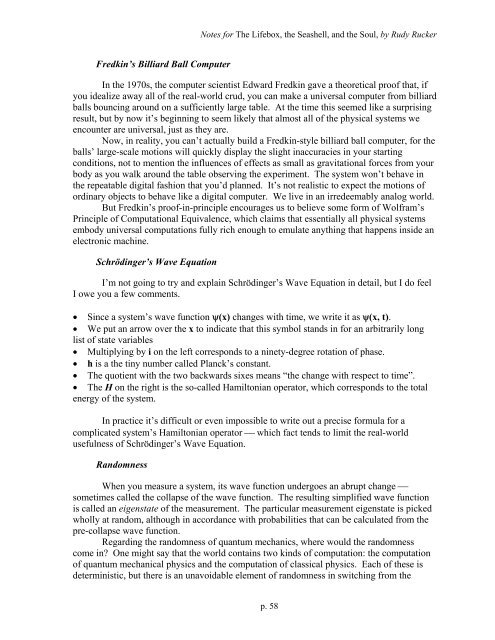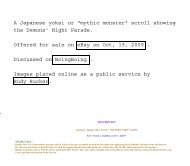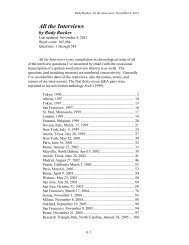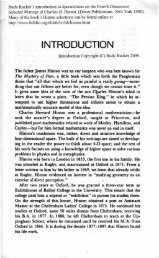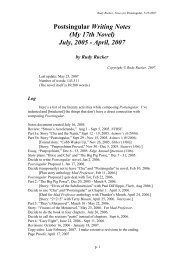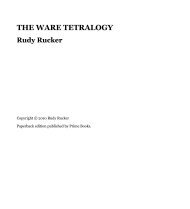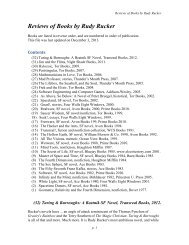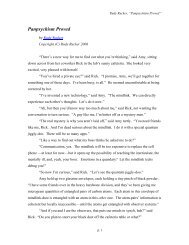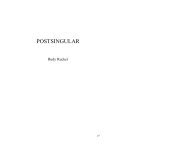Notes for the Lifebox, the Seashell, and the Soul - Rudy Rucker
Notes for the Lifebox, the Seashell, and the Soul - Rudy Rucker
Notes for the Lifebox, the Seashell, and the Soul - Rudy Rucker
You also want an ePaper? Increase the reach of your titles
YUMPU automatically turns print PDFs into web optimized ePapers that Google loves.
<strong>Notes</strong> <strong>for</strong> The <strong>Lifebox</strong>, <strong>the</strong> <strong>Seashell</strong>, <strong>and</strong> <strong>the</strong> <strong>Soul</strong>, by <strong>Rudy</strong> <strong>Rucker</strong><br />
Fredkin’s Billiard Ball Computer<br />
In <strong>the</strong> 1970s, <strong>the</strong> computer scientist Edward Fredkin gave a <strong>the</strong>oretical proof that, if<br />
you idealize away all of <strong>the</strong> real-world crud, you can make a universal computer from billiard<br />
balls bouncing around on a sufficiently large table. At <strong>the</strong> time this seemed like a surprising<br />
result, but by now it’s beginning to seem likely that almost all of <strong>the</strong> physical systems we<br />
encounter are universal, just as <strong>the</strong>y are.<br />
Now, in reality, you can’t actually build a Fredkin-style billiard ball computer, <strong>for</strong> <strong>the</strong><br />
balls’ large-scale motions will quickly display <strong>the</strong> slight inaccuracies in your starting<br />
conditions, not to mention <strong>the</strong> influences of effects as small as gravitational <strong>for</strong>ces from your<br />
body as you walk around <strong>the</strong> table observing <strong>the</strong> experiment. The system won’t behave in<br />
<strong>the</strong> repeatable digital fashion that you’d planned. It’s not realistic to expect <strong>the</strong> motions of<br />
ordinary objects to behave like a digital computer. We live in an irredeemably analog world.<br />
But Fredkin’s proof-in-principle encourages us to believe some <strong>for</strong>m of Wolfram’s<br />
Principle of Computational Equivalence, which claims that essentially all physical systems<br />
embody universal computations fully rich enough to emulate anything that happens inside an<br />
electronic machine.<br />
Schrödinger’s Wave Equation<br />
I’m not going to try <strong>and</strong> explain Schrödinger’s Wave Equation in detail, but I do feel<br />
I owe you a few comments.<br />
• Since a system’s wave function ψ(x) changes with time, we write it as ψ(x, t).<br />
• We put an arrow over <strong>the</strong> x to indicate that this symbol st<strong>and</strong>s in <strong>for</strong> an arbitrarily long<br />
list of state variables<br />
• Multiplying by i on <strong>the</strong> left corresponds to a ninety-degree rotation of phase.<br />
• h is a <strong>the</strong> tiny number called Planck’s constant.<br />
• The quotient with <strong>the</strong> two backwards sixes means “<strong>the</strong> change with respect to time”.<br />
• The H on <strong>the</strong> right is <strong>the</strong> so-called Hamiltonian operator, which corresponds to <strong>the</strong> total<br />
energy of <strong>the</strong> system.<br />
In practice it’s difficult or even impossible to write out a precise <strong>for</strong>mula <strong>for</strong> a<br />
complicated system’s Hamiltonian operator ⎯ which fact tends to limit <strong>the</strong> real-world<br />
usefulness of Schrödinger’s Wave Equation.<br />
R<strong>and</strong>omness<br />
When you measure a system, its wave function undergoes an abrupt change ⎯<br />
sometimes called <strong>the</strong> collapse of <strong>the</strong> wave function. The resulting simplified wave function<br />
is called an eigenstate of <strong>the</strong> measurement. The particular measurement eigenstate is picked<br />
wholly at r<strong>and</strong>om, although in accordance with probabilities that can be calculated from <strong>the</strong><br />
pre-collapse wave function.<br />
Regarding <strong>the</strong> r<strong>and</strong>omness of quantum mechanics, where would <strong>the</strong> r<strong>and</strong>omness<br />
come in? One might say that <strong>the</strong> world contains two kinds of computation: <strong>the</strong> computation<br />
of quantum mechanical physics <strong>and</strong> <strong>the</strong> computation of classical physics. Each of <strong>the</strong>se is<br />
deterministic, but <strong>the</strong>re is an unavoidable element of r<strong>and</strong>omness in switching from <strong>the</strong><br />
p. 58


